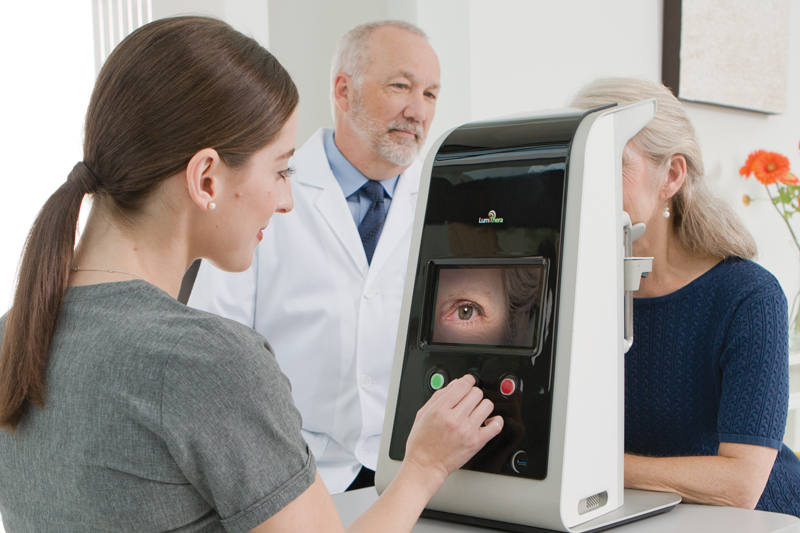LIGHTSITE I CLINICAL TRIAL
The LIGHTSITE I (NCT02725762) study is the first prospective, sham-controlled, double-masked clinical study to evaluate the effectiveness of photobiomodulation (PBM) treatment in patients with dry age-related macular degeneration (AMD) using the Valeda® Light Delivery System [Canada]. Subjects were to be treated with 2 series of multiwavelength PBM or Sham treatment delivered 3x per week over 3-4 weeks every 6 months. The study included 46 eyes (30 subjects) and subject participation lasted 12 months. Results from the LIGHTSITE I study showed clinical improvements in visual and anatomical outcome measures following multiwavelength PBM. Improvements were observed in Best-Corrected Visual Acuity (BCVA), Contrast Sensitivity (CS), microperimetry, and Quality of Life (QoL) in addition to improvements in pathological hallmarks of disease including central drusen volume and thickness. No device-related adverse events were reported throughout the course of the study highlighting a favorable safety profile. These data provided a strong foundation for the utility of PBM therapy and demonstration of disease-modifying effects prompting additional studies.
The PBM therapy was most beneficial in dry AMD subjects immediately following the completion of each treatment series and lost some benefit throughout the 6-month treatment interval, highlighting a need for follow-up maintenance therapy. The LIGHTSITE I results were used to refine the subsequent multi-center clinical trials in Europe (LIGHTSITE II) and the USA (LIGHTSITE III).
The LIGHTSITE II (NCT03878420) study is a double-masked, sham-controlled, parallel design, prospective, multi-site study for the use of PBM as a treatment for visual impairment in subjects with dry AMD [Europe]. Subjects were to be treated with 3 series of multiwavelength PBM or Sham treatment delivered 3x per week over 3-5 weeks every 4 months. The study aimed to enroll up to 144 eyes (96 subjects) in up to 16 sites across Europe. The study included 53 eyes (44 subjects) across 7 sites and subject participation lasted 10 months. The LIGHTSITE II study was underway when the COVID-19 viral outbreak occurred. This global public health emergency significantly impacted the conduct of the clinical trial. LumiThera put the study on hold for 11+ weeks and then decided to terminate new subject enrollment permanently and converted the study to a feasibility study. While COVID-19 had a significant interference on study design, improvement in visual outcomes in patients that completed all rounds of PBM treatment were observed. PBM-treated eyes showed statistically significant improvement in BCVA at Month 9 (p = 0.02) with a ~4-letter gain versus a 0.5-letter gain in the Sham group (p = 0.10). Approximately 35.3% of PBM-treated eyes showed ≥ 5-letter improvement at 9 months. While PBM and Sham groups both showed GA lesion growth in the trial period, there was 20% less growth in the PBM group over 10 months, suggesting potential disease-modifying effects. No safety concerns or signs of phototoxicity were observed. Overall, these findings further support the data from the LIGHTSITE I study.
The LIGHTSITE III (NCT04065490) study is a double-masked, sham-controlled, parallel design, prospective, multi-site study on the long-term use of PBM as a treatment for visual impairment in early/intermediate dry AMD [USA]. Subjects were treated with 6 series of multiwavelength PBM or Sham treatment delivered 3x per week over 3-5 weeks every 4 months. The study included 148 eyes (100 subjects) across 10 sites and participation lasted 24 months. LIGHTSITE III met the predetermined primary efficacy endpoint of BCVA with a statistically significant difference between PBM and Sham groups at Month 21 (p = 0.0036) and a gain of 6.2 letters following PBM treatment. A mean letter gain of 5.6 letters in the PBM group was maintained at Month 24 (p = 0.0024). At Month 21, approximately 63.7% of PBM-treated eyes had a ≥ 5 letter gain (mean of 8.8 letters) vs. 22.2% of Sham-treated eyes (mean of 9.8 letters), 18.7% of PBM-treated eyes had a ≥ 10 letter gain (mean of 12.8 letters) vs. 7.4% of Sham-treated eyes (mean of 13.8 letters), and 4.4% of PBM-treated eyes had a ≥ 15 letter gain (mean of 16.3 letters) compared to 1.9% of Sham-treated eyes (mean of 22.0 letters). PBM significantly decreased the occurrence of new onset geographic atrophy (p = 0.007; Sham, 24.0% vs. PBM, 6.8%) and reduced the hazard ratios for BCVA vision loss (p < 0.02) and incident GA (p < 0.006) occurrence. The VFQ-25 QoL composite score (p = 0.018) and select subscales were improved. A favorable safety profile was observed with no signs of phototoxicity and no deterioration in other visual outcomes including contrast sensitivity, low luminance BCVA, Radner reading, perimetry, or color vision. The LIGHTSITE III trial results supported the De Novo regulatory application submitted to the FDA leading to authorization of Valeda for treatment of patients with dry AMD.
The ELECTROLIGHT (NCT04522999) is an open label, prospective, pilot clinical study to assess the effects of PBM and electroretinography (ERG) in subjects with Dry AMD. ERG is a quantitative and functional measure of visual output in the diagnosis and management of AMD. Subjects were treated with one series of multiwavelength PBM treatment delivered 3x per week over 3-4 weeks. The study included 23 eyes (15 subjects) at a single site and subject participation lasted 6 months. ERG protocols included multi-focal (mf-ERG), and multi-luminance (ml-ERG). Significant improvements of visual output were observed over the 6-month time course. Subjects showed an improvement in ml-ERG that was additive across the 9 PBM treatment sessions. PBM improved ml-ERG magnitude by 14.4% at Month 1 with a reduction to near baseline (BL) levels at Month 3. A moderate improvement in ml-ERG was observed at Month 6. PBM-treated subjects showed consistent improvements in BCVA following PBM treatment and a sustained vision improvement at Month 6 (p < 0.001). An approximate 12 letter (BCVA) vision improvement at Month 1, 3 and 6 was observed (p <0.001). Significant improvement in contrast sensitivity and in the Amsler grid test were also observed. Valeda showed a positive safety profile with no signs of phototoxicity and a low rate of adverse events. These results support the use of PBM in dry AMD patients and the utility of ERG as a functional indicator for changes in retinal output.
https://clinicaltrials.gov/study/NCT04522999?term=Electrolight&rank=1
Ongoing Clinical Trials
For information on the studies and their site locations can be found at www.clinicaltrials.gov.
LumiThera Financial Conflict of Interest Policy
COR-0015 REV A LumiThera Financial Conflict of Interest Policy



